
No, Virginia, that squiggly brown thing near the bottom edge of the photo is not in fact a slug, literary or otherwise: I think it’s merely a well-camouflaged stick. Because I love you people — and because so many of you have told me that you tune into Author! Author! first thing in the morning, perhaps so you may peruse it while sipping your favorite caffeinated morning beverage — I would not present you with a close-up of a slug, stealthily or otherwise.
Hey, Millicent the agency screener’s not the only one susceptible to performing a spit-take with a too-hot latte.
Have we been talking so intensely about the first couple of pages of your manuscript — the title page, the first page of text — that standard format has invaded your dreams yet? I wouldn’t be entirely surprised if it had: this series on what professional manuscripts look like has been both example-ridden and extraordinarily nit-picky, even by my standards of detail-orientation. So you probably won’t be altogether astonished to learn that before we move on from the first page of the text (and of each chapter) to considering an ordinary page, I want to devote today to pagination.
And slug-lovers everywhere rise up to dance in the rain-slick streets!
Seriously, don’t groan; it’s an important issue. Not numbering your manuscript, book proposal, or contest entry’s pages an almost universal instant rejection offense; trust me, Millicent is going to notice how and if you do it. In fact, as cosmetic issues go, how and where an aspiring writer chooses to place the page number on the page can tell our Millie a tremendous amount about him.
Specifically, whether he has done his homework about submission, because there is only one place on a manuscript page that it is permissible to place a page number: in the slug line.
Is everybody quite sure where that is on the page? Just to be on the safe side, let’s take another gander at an example from last time.
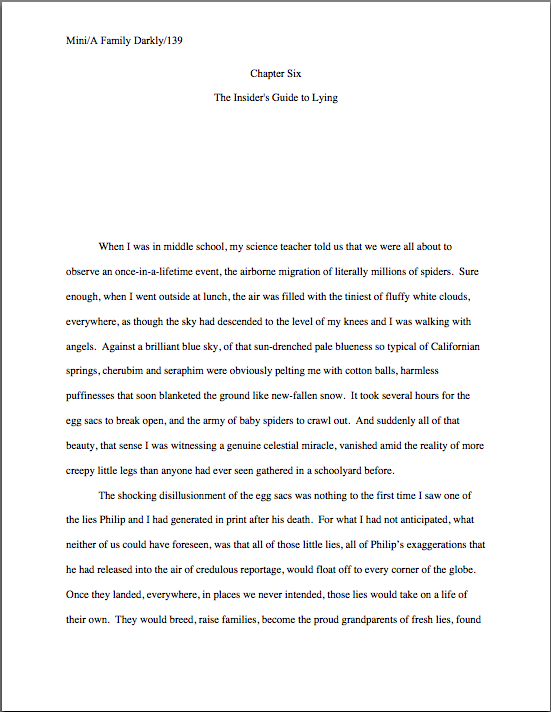
See the slug frolicking in the upper left-hand margin? How happy it looks in its natural habitat.
The top margin is the page number’s natural habitat as well — which seems to come as a surprise to many aspiring writers. Let’s go ahead and forge a new axiom about it: the page number belongs within the slug line, rather than anywhere else on the page.
This is as proper on page 139 of a book manuscript as on page one. While we’re noticing such things, I would also like to call your attention to the fact that in each of these examples, the page’s only reference to the author’s name or the title of the book appears in the slug line.
That, too, would work equally well on p. 139 as on page 1. Sensing a pattern here?
I sincerely hope so, because the slug line confuses a lot of aspiring writers; until you have seen piles and piles of professional manuscripts, it looks kind of funny. So much so that to some would-be submitters, heads swimming from having been told over and over again that a manuscript should have a 1-inch margin on all sides, find it counterintuitive to add a line of text, even such a short one, within that margin.
But I assure you, it’s traditionally done that way. And why? Intrepid ‘Palooza followers everywhere, chant it with me now: because like every other aspect of standard format for manuscripts, placing the slug line there just looks right to professional readers.
Yes, that logic is a trifle tautological, now that you mention it. If you have a problem with that, I would suggest taking it up with the powers that rule the universe. As I believe I may have pointed out once or twice earlier in this autumn of ‘Paloozas, I do not count myself amongst those powers.
If I did, Microsoft Word would be set up to create documents in standard format automatically, Word for Mac and Word for Windows would be set up so those using one could easily give formatting advice to those using the other, air pollution would be merely a thing of distant memory, and ice cream cones would be free on Fridays. Oh, and the little girl across the street who believes slugs are her totem animal would come to liberate her little friends from my garden on a daily basis, rather than on a monthly one.
As none of these things seems to be true, let’s get back to business: how does one create that pesky slug line, anyway?
Back in the days when typewriters roamed the earth, it was perfectly easy to add a slug line to every page: all a writer had to do was insert it a half-inch down from the top of the page, left-justified, floating within the 1-inch-deep top margin. For word-processed documents, it’s a trifle more complicated.
The slug line still belongs in the same place, .5 inches from the top of the paper, suspended in the middle of the requisite 1-inch top margin. But instead of laboriously typing it on each page individually as writers did in the bad old days, one simply inserts it in the header. In most versions of Word (I can’t speak for all of them), the header may be found under the VIEW menu.
Before the Luddites out there trot out their usual grumble about the bother of tracking down the bells and whistles in Word, think about this: placing the slug line in the header also enables the writer to take advantage of one of the true boons of the advent of word processing, pages that number themselves.
As opposed to having to do it manually, laboriously retyping the slug line in its entirety on each and every page of the manuscript.
Oh, you may laugh, but several times each year, I receive a manuscripts constructed by a writer who was not aware that Word would do this for her. Instead of utilizing the header function, the poor writer will have elected to include the necessary information on the first line of text on the page.
Not only does this unfortunate misconception involve an absolutely monumental and ultimately unnecessary effort, but the result doesn’t pass the all-important does it look right? test. Take a peek for yourself:
See how pulling the slug line down into the text messes with the spacing of the page? Here, an entire line of text is sacrificed to it — and let me tell you, that line is not going to go quietly.
How so, you ask? Well, think about it: what’s inevitably going to happen if the author decides to insert a new sentence or two on a page formatted this way? That’s right: the writer is going to have to go back and move each and every one of those slug lines to match the NEW pagination.
I’d show you a practical example of this, but it’s just too tragic to contemplate. Trust me, it would be a heck of a lot of work, and writers who do it are likely to end up beating their heads against their studio walls.
Take a moment to peruse that last example again. See any other problems with the slug line? How about the fact that it includes the word page? Shouldn’t be there; just the numbers will suffice.
Did I just hear some huffs of indignation out there? “But Anne,” the formatting-ambitious cry, “I think it looks kind of classy to include page before the page number? It’s kinda stylish. If it’s just a matter of personal style, who could possibly be hurt by including it, if I like the way it looks?”
Well, you, for starters. And why? (Chanters, ready your lungs.) Because it just would not look right to someone who reads manuscripts, book proposals, or contest entries on a regular basis.
No kidding — I’ve seen screeners get quite indignant about this one. “Does this writer think I’m stupid?” Millicent is prone to huff. (Don’t bother to answer that question; it’s rhetorical.) “Does she think I don’t know that the numeral that appears on every page refers to the number of pages? Does she think I’m going to go nuts and suddenly decide that it is a statistic, or part of the title? Or maybe a wayward date that’s wandered off to the wrong part of the page?”
Don’t bait her; the lady has a hard life, even when she doesn’t accidentally burn her lip on a too-hot latte. Make her happy: do it the approved way.
Okay, did you spot any other problems? What about the fact that the first character is in a different typeface from the rest of the text? Or the equally disturbing fact that the first paragraph of the chapter is not indented?
Again, the writer may consider this nifty, but I can assure you, Millicent won’t. Fortunately for her blood pressure, the odd typeface for the first letter, in imitation of the illuminated texts hand-written by monks in the Middle Ages, doesn’t turn up all that often in manuscripts other than fantasy and YA, for one simple reason: books in that category are more likely to feature this it’s-a-new-chapter signal than others. But once again, what an editor may decide, rightly or wrongly, is appropriate for a published book has no bearing upon what Millicent expects to see in a manuscript.
Save the manuscript illumination for someone who will appreciate it. Hop in your time machine and track down a medieval monk to admire your handiwork, if you like, but in this timeframe, keep the entire manuscript in the same typeface and size.
The non-indented first paragraph of a chapter is fairly common in mystery submissions, I have noticed, and starting to become more prevalent in other kinds of fiction as well of late. (For an interesting discussion about why, please see the comments on this post and this one.) In fact, I’ve been told by many mystery writers — and rather tersely, too — that eschewing indentation in this context is an homage to the great early writers in the genre, an echo of their style, so who is yours truly to try to talk them out of that gesture of respect?
Well, since you asked, I’m someone familiar with what Millicent expects to see on a page — as well as someone who is aware that almost without exception, in Edgar Allan Poe’s time all the way down to our own, the editor has determined the formatting that appeared on any given printed page, not the author. To professional eyes, especially professionally peevish ones like Millicent’s, a manuscript that implicitly appropriates this sort of decision as authorial might as well be the first step to the writer’s marching into Random House, yanking off a well-worn riding glove, and striking the editor-in-chief with it.
It’s just not a good idea for someone brand-new to the biz to do.
Yes, you read that correctly: non-standard formatting choices are occasionally interpreted as a challenge to editorial authority. And while we could speculate for the next week about the level of insecurity that would prompt regarding a minor formatting choice as a harbinger of incipient insurrection, is the manuscript of your first book really the right place to engender that discussion amongst Millicent and her cronies?
Exactly. Save the formatting suggestions for a long, intimate discussion over coffee with your editor after she acquires the book. You’ll probably lose any disagreement on the subject, but at least you will have made your preferences known. Until that happy, caffeine-enhanced day, just accept that the industry prefers to see every paragraph in a manuscript indented the regulation half-inch.
It just looks right that way.
While we’re at it, how about the bolded chapter number and title in that last example? Nothing in a manuscript should be in boldface. Nothing, I tell you. Uh-uh. Not ever. (Except for that nonfiction exception we talked about last time. And I have seen authors get away with bolding the title on the tile page, but frankly, I wouldn’t chance it in a first book submission.)
Nor should anything be underlined — not even names of books, magazines, or song titles. Instead, they should be italicized, as should words in foreign tongues that are not proper nouns.
Yes, Virginia, back in the day when typewriters roamed the earth, underlining was the norm, for the simple reason that most typewriters did not have italic keys. So if you consult an older list of formatting restrictions or one intended solely for short story formatting — both of which seem to be circulating at an unprecedented rate on the web of late, pretty much always billed as universally-applicable rules for any type of writing, anywhere, anyhow, a phenomenon which simply does not exist — you might conceivably be told that publications, song titles, and/or foreign words (sacre bleu!) should be underlined. But trust me on this one: any agent is going to tell you to get rid of the underlining, pronto.
And why? All together now: because it just doesn’t look right that way.
All right, campers, do you feel ready to fly solo into a critique of a first page? Here are two pages of text, studded with standard format violations for your ferreting-out pleasure:
How did you do? Are those problems just leaping off the page at you now? If not, ask yourself: does that first page contain information that ought to be on the title page instead? Are the margins even? Are the paragraphs formatted correctly? And so forth.
In fact, it’s a terrific idea for any aspiring writer to get into the habit of asking those types of questions immediately after clapping eyes upon any manuscript, his own or anybody else’s. Why? Because that’s Millicent’s first instinct. However literature-loving a she may be, she sees so many incorrectly-formatted submissions that a properly-formatted one automatically looks at first glance like more professional writing to her.
As, with practice, it will to you. I promise. To get that ball rolling, as well as to reward you for so much hard work — or to provide you with some helpful comparison, depending upon how you did on that last little test — here are a couple of correctly-formatted pages, to soothe your tired eyes:
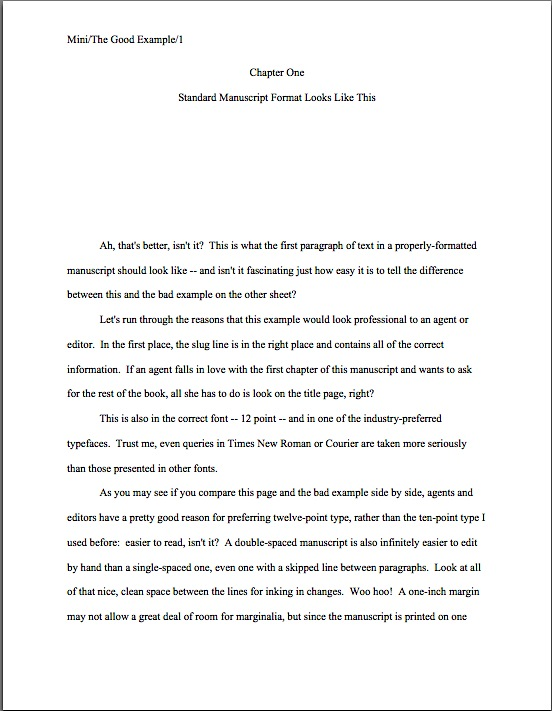
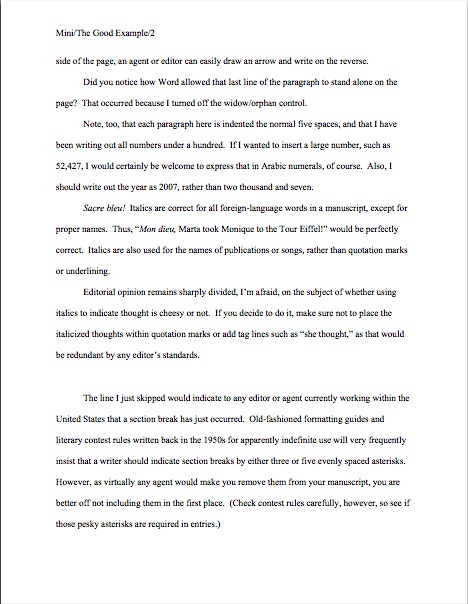
Whenever you start finding yourself chafing at the rules of standard format, come back and take a side-by-side gander at these last sets of examples, to regain perspective on what standard format is and why it’s important in a submission, proposal, or contest entry. I assure you, after a professional reader like Millicent has been screening manuscripts all day, every day for even a couple of months, every time she sees the bad example, mentally, she’s picturing the good example right next to it.
Small wonder, then, that — wait for it — manuscripts that look right get taken more seriously than those that don’t. Regardless of how you may feel about Millicent’s literary tastes, isn’t a serious read from her what you want for your book? Or your book proposal? Or your contest entry?
Did you notice that I snuck us from the first page of the text into the second in my last example? Next time, we’ll continue delving into the mysteries of the mid-manuscript page. On Friday, I’ll be offering a little reward for all of your virtue.
Hey, if treading the path of virtue is rewarded nowhere else on earth, it is here at Author! Author! Keep up the good work!
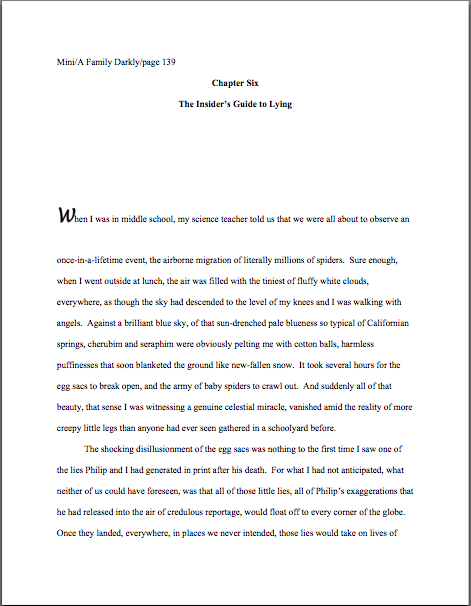

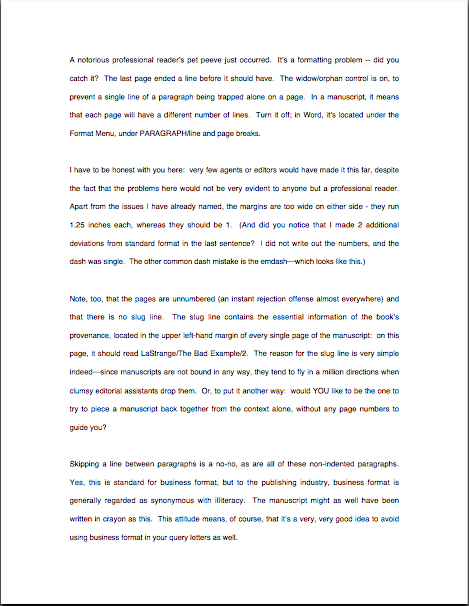
Anne,
Should there be 23, 24, or 25 lines per page in standard manuscript format?
thanks
Jens
23, Jens, if it’s a full, double-spaced page that isn’t either the beginning or the ending of a chapter. Is your word-processing program suggesting other alternatives?
Anne,
A one-inch bottom margin in MS Word produces a printed bottom margin of one and 6/16ths of an inch and 23 lines/page.
If you change the bottom margin in MS Word to .99 in (that’s 99/100ths of an inch), you get a printed bottom margin of exactly one inch and 24 lines per page.
Unless you looked at the MS Word settings, you would never know — 1/100 of an inch is smaller than the black marks on my ruler.
Also, weren’t industry word count estimates originally based on 25/page X 10 words in Courier per line?
You see my confusion.
I would like to cram 24 lines on a page, especially for printed submissions where it would be impossible to note a different 1/100ths of an inch… unless they were really expecting 1 6/16ths of an inch.
?
Jens
I’m not an expert in the mysteries of Word for the PC, Jens, but does 6/16ths mean 3/8ths of an inch, which is actually quite substantial? If your bottom margin is as far off as 3/8ths of an inch, there is something wrong with the settings. If you are using standard settings and are still getting that outcome, I would suggest consulting a computer expert about it, rather than trying to press the boundaries of the extant rules of standard format.
As much as I would like to be able to wave a wand and say no harm will come to you if your manuscript has an extra line per page, someone who stares at manuscripts all day long for years on end will notice that your pages are longer than everyone else’s. They will be, because the norm is to set the bottom margin to 1″ and let Word do the work.
If you’re getting 23 lines per page, it is doing its work. The mere fact of being able to fit more words on the page is not necessarily a guarantee that the result will look right to a professional reader; there’s no shortage of submitters and contest entrants who believe that their tweaks to cram more words on a page are undetectable. They might be to someone who sees only one manuscript page, but Millicents see thousands per week. The ones that have an extra line per page, like those whose type is unusually small, stick out like the proverbial sore thumb.
That doesn’t mean it’s not a reasonable question, though; actually, I’m rather glad you asked it, because so many aspiring writers believe that margin expectations are just a hoop through which to jump at submission time, rather than a professional expectation that renders a manuscript easier for the pros to handle if they decide to pick up the book. So I’ve included an example of a 24-line page in Formatpalooza XII, in order to talk about this problem at greater length. I hope you’ll find it helpful.
And the answer to your question about Courier is no: estimates were not originally based upon typefaces at all, but upon the Pica (10 characters per inch) and Elite (12 characters per inch) typewriter keys. But why would that be relevant here? The estimation calculation is 200 words/page x # of pages for Courier, 250 words/page x # of pages for Times New Roman; as I explain in the HOW TO ESTIMATE WORD COUNT — AND WHY posts, no one seriously believes that this is an accurate reflection of the number of words per page. It does, however, tell the pros something about how expensive the manuscript would be to print.
Yet another reason that it’s never a good idea for a submitter to assume that the rules don’t have practical applications of which he is unaware. I’m sure you don’t think of adding the extra line of text as gaming the system, but a professional reader might well — and with some justification. Since the spacing on the page is far, far more important for the editor than the writer, it only makes sense to abide by the rules the publishers have set up.
Anne,
I hear what you’re saying, but I don’t think you’ve quite understood my question.
Namely:
Does standard manuscript format dictate one-inch margins on *paper*, or in *Microsoft Word*?
Take your properly-formatted Dickens example in post 12. Print it out. Whip out your ruler and measure the bottom margin. I’ll wager you will indeed come up with a 1 6/16th inch margin. (I say 6/16ths and not 3/8ths because my ruler is marked down to the sixteenth of an inch.)
Now it may well be the case that an actual one-inch margin has gone the way of the dodo bird because of the quirks in Microsoft Word, and editors and agents have grown so accustomed to seeing such a huge bottom margin (1 6/16ths of an inch) that anything less will automatically strike them as strange.
On the other hand, if we’re talking about following the rules to the letter (as you so regularly encourage us to do), then a one-inch margin is just that, and can only be achieved by tricking Word into giving us that 24th line.
See what I mean?
Jens
I believe I did understand your question, Jens: you’ve simply asked it in a different form this time. You want to make this about how stupid Word is for not automatically producing a 1-inch bottom margin, as opposed to one that is at least 1 inch, but as I say early and often in this forum there is no relationship between the folks who make decisions in the publishing industry and those who design the latest version of Word. For that reason, if for no other, no matter how many times you whip out a ruler, since the standard is 23 lines per page — consistent in every single practical example I have given in this series — it’s irrelevant that you could conceivably toy with your version of Word to shoehorn in an additional line.
The issue here is what a professional reader would expect to see on the page. As I have discussed both in this series and in the comments on this very post, what they expect is for writers to set a 1-inch bottom margin in their Word programs, to mimic what would be the bottom margin in a typed page. But since lines of text take up a predetermined amount of space on the page, there is a maximum number of lines that standard margins will allow. On both a typewriter and in Word, that maximum is 23 double-spaced lines, so nothing here has gone the way of the dodo.
The fact that the bottom margin is not precisely 1 inch is thus completely irrelevant; this is about expectation, not obsessively measuring actual margins. No professional reader — including, incidentally, yours truly when asked to print out her online examples and apply rulers to them; although I do write long posts and devote a lot of time to answering individual questions, my time is not in fact unlimited — would waste her time doing that. If it looks wrong by professional standards, it looks wrong. It honestly is that simple, and no matter how much aspiring writers want to make the margin expectations more complicated than they actually are (you’re certainly not alone in this particular obsession), it just doesn’t make sense to believe that the publishing industry expects every writer out there to mess with his Word setting until the bottom margin is precisely 1 inch. As I said before, they expect writers to set the bottom margin for 1 inch and get back to the more important business of writing.
This is not a secret handshake, a code that a savvy aspiring writer can break, nor is it a challenge to see who can fit the most words within the usual restrictions. It is simply a professional expectation.
If one chooses (unwisely) to question that expectation, the secondary question becomes whether the only way the pros determine whether a submitter has followed these guidelines is by the width of the bottom margin, rather than by what they see day in, day out as the proper number of lines per page. It is the latter, but the very question assumes that it is the white space itself, and not the approximate number of characters per page, were the reason they wanted all manuscripts to be uniform. But that is not true. There are printing considerations — and even if there weren’t, it simply doesn’t make sense that people outside the publishing industry would be able to decide that since it is technically possible to tinker with the text to add an extra line per page, the people within the industry must accept it.
So to recap the questions and answers so far: is there a standard number of lines on the page? Yes. Would what you are proposing look wrong on the page? Yes. Would that still be true even if you could be standing next to Millicent with a ruler to prove that you had adhered to the letter of the rule while violating its spirit? Yes. If you could manage to sneak in an extra line without messing at all with the per-line spacing and still have a 1-inch bottom margin, would any experienced Millicent assume that you were showing an essential disrespect for the rules of standard format, and conclude that you were trying to hide an over-long manuscript thereby? Yes.
And might a well-meaning writer who didn’t quite understand the 1-inch margin vis-à-vis the number of lines per page inadvertently run afoul of that rule? Possibly — but not if he set his bottom margin to 1″. So would there be any benefit other than tinkering with the margins so that they are exactly 1 inch? No.
And am I just trifle annoyed that after I went to all the trouble of constructing a visual example and explanation of this very point in Formatpalooza XII and put the link to it here in the comments, you seem not to have checked it out before asking me to revisit this point from another angle? The answer to that is yes, too; it’s really much less efficient for me to invest the time to answer questions like this individually in the comments of not-very-closely related posts than to address them in the forum to which most readers gravitate. If you still have questions about it after you read that post, please ask them there, where other readers might conceivably benefit from the discussion — and where the answers are searchable.
I’ve also noticed that when setting the lower margin to exactly one inch, that there seems to be room for an additional (twenty-fourth) line. I usually set the bottom margin at .9 so that final line will be included. Apparently no one has noticed, at least not enough to comment on it. Physically measuring the resultant page shows what appears to be the required one inch margin.
Dave